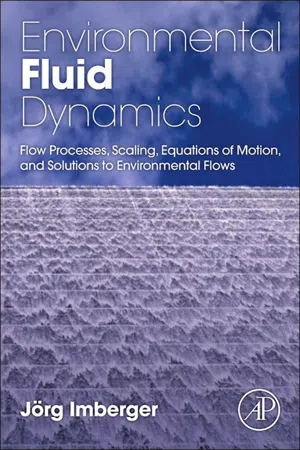
Environmental Fluid Dynamics
Flow Processes, Scaling, Equations of Motion, and Solutions to Environmental Flows
Jorg Imberger
- 460 pagine
- English
- ePUB (disponibile sull'app)
- Disponibile su iOS e Android
Environmental Fluid Dynamics
Flow Processes, Scaling, Equations of Motion, and Solutions to Environmental Flows
Jorg Imberger
Informazioni sul libro
Environmental Fluid Dynamics provides an introduction to the principles of environmental fluid dynamics, i.e., nature's use of air and water to transport and transform waste into nutrients for various organisms.
The author, a Professor of Environmental Engineering and the Director of the Centre for Water Research at the University of Western Australia, is careful to include the appropriate mathematical expressions for the fundamentals of fluid dynamics without overburdening the reader with difficult or extensive notation.
Starting with a discussion of the basics of fluid dynamics for undergraduates, the book moves on to more detailed material for graduate students and specialists in environmental engineering and/or science, physical limnology, estuarine dynamics, and coastal oceanography. Topics covered include equations of motion, fluid viscosity, environmental hydraulics, mixing and dispersion, surface waves, and environmental flows. The materials presented are based on the author's 40 years of teaching fluid dynamics at Berkeley, Caltech, Karlsruhe, Padova, and Western Australia.
The book provides a basic overview, while specialists needing more in-depth information can to turn to advanced texts in their specific areas of interest.
- Introduces the principles of fluid dynamics, follows with simple applications, and builds to more complex applications experienced in the field
- Offers a unique, authoritative, and accessible treatment of the subject
- Includes appropriate mathematical expressions without overburdening the reader with difficult or extensive notation